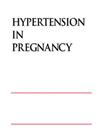Lu等人关于文章“埃索美拉唑和磺胺嘧啶联合使用可减少sFlt-1分泌并减少内皮功能障碍:联合治疗子痫前期的潜力”的信。
IF 2.1
4区 医学
Q3 OBSTETRICS & GYNECOLOGY
Hypertension in Pregnancy
Pub Date : 2022-02-01
Epub Date: 2022-01-02
DOI:10.1080/10641955.2021.2024224
引用次数: 0
摘要
本文章由计算机程序翻译,如有差异,请以英文原文为准。
Letter by Lu et al. regarding article, "Esomeprazole and sulfasalazine in combination additively reduce sFlt-1 secretion and diminish endothelial dysfunction: potential for a combination treatment for preeclampsia".
We read with the great interest the article by Brownfoot et al., titled “Esomeprazole and sulfasalazine in combination additively reduce sFlt-1 secretion and diminish endothelial dysfunction: potential for a combination treatment for preeclampsia” (1). The authors deciphered the potential therapeutic value of combined someprazole and sulfasalazine additively in reducing the secretion of soluble fms-like tyrosine kinase 1 (sFlt-1) and soluble endoglin (sENG) for the pathogenesis of preeclampsia (PE), which was identified as new candidate medication to treat or prevent PE. Previously, we have noticed that the impacts of PE on women are not limited to the pregnancy itself but rather extended to the long-term life (2). Studies have demonstrated consistently that post-PE women were at higher risk of developing cardiovascular disease later in life, such as ischemic heart disease, stroke and heart failure, and so on (3,4). Brown and Wu et al. have found that women with a history of PE had the increased incidence of chronic kidney disease (CKD) and end-stage renal disease (ESRD) (5,6). In addition, it became more apparent that there was significant relation between insulin resistance and formerly PE (7). Notably, emerging evidence proving EGFR and sFlt-1 signaling pathways was associated with the long-term complications in PE became available (8). In light of the exciting clues, we wondered whether the available follow-up about long-term complication among women with PE and consequently the survival quality analysis would be included in evaluating the effectiveness of combining esomeprazole and sulfasalazine in extended studies for broadening our understanding of its effect. Hence, it was worth elucidating the long-term survival quality analysis, which might shed some light on the clinical value of combining esomeprazole and sulfasalazine and contribute to improve the prognosis of PE. Finally, we congratulate that the authors identified the combination of esomeprazole and sulfasalazine as the novel therapeutic strategies in PE and look forward to that our interest will stimulate intriguing findings carried out on the clinical use of esomeprazole and sulfasalazine.
求助全文
通过发布文献求助,成功后即可免费获取论文全文。
去求助
来源期刊

Hypertension in Pregnancy
医学-妇产科学
CiteScore
3.40
自引率
0.00%
发文量
21
审稿时长
6 months
期刊介绍:
Hypertension in Pregnancy is a refereed journal in the English language which publishes data pertaining to human and animal hypertension during gestation. Contributions concerning physiology of circulatory control, pathophysiology, methodology, therapy or any other material relevant to the relationship between elevated blood pressure and pregnancy are acceptable. Published material includes original articles, clinical trials, solicited and unsolicited reviews, editorials, letters, and other material deemed pertinent by the editors.
 求助内容:
求助内容: 应助结果提醒方式:
应助结果提醒方式:


